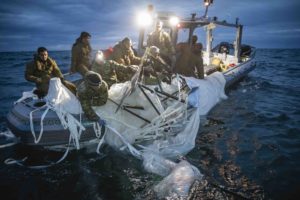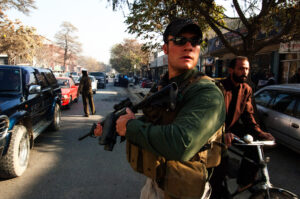A friend of mine landed himself in serious trouble after reading a Pentagon report on a plane: the passenger alongside him, another US Defense Department bureaucrat, reported him for reading a “classified” document in public. Yet like a great many such documents, it only had one page that contained classified information. In fact, it only included a single classified sentence, itself of trivial importance.
But, as a result, every page was stamped CLASSIFIED in capital letters, both above and below the text. In the end, my friend, despite the support of his colleagues and office chief, had no choice but to resign.
To this day, vast reams of pseudo-secret documents are manufactured whenever a Diplomatic, Consular or State Department official adds a comment to the lengthy daily media summaries produced by every US diplomatic post across the world. And if the comment is from a member of the local CIA station (perhaps to the effect that so-and-so is at it again with some anti-American comment), this trivial addition becomes “super-secret”, even though its contents are still 99.99% publicly available as an “open-source” material that all in the organisation can see.
Yet this daily output is only a mere rivulet when compared to the Amazonian flow of documents produced by the Army, Navy, Marine Corps and Air Force, who are equally liberal in elevating trivia to “secret” or even “top-secret” status. But they are all outclassed by the Navy’s nuclear submariners, for whom even a toothpaste order is issued “for official use only”, and the US Special Operations Command — which used to be the Joint Special Operations Command, of which I was once the sole consultant — whose toothpaste purchase order are not just “official use” but “secret”, if not more.
Even with genuine secrets, such as the scope and limits of “overhead” (satellite) photography, there is habitual and extreme exaggeration. Long ago, an exceptionally competent National Security Council official and that rare thing, a genuine “country expert”, asked me to visit his office to discuss some phrases I had included in a report for the Defense Department. It contained not a jot of secret data, but was nevertheless stamped “for official use only”, the equivalent of “Airman 1st class” in the hierarchy of secrecy.
In deference to the rules, I kept no copy of my own at home, so he arranged for the document’s delivery from the Pentagon via official mail, and we sat down to discuss the phrases in question. It turned out they contained information that he believed was very, very important — he planned to take it to the President — and, to make his point, he impulsively whipped out another report that included a small black-and-white satellite photograph of very small rectangles (Russian tanks) on his country’s border.
There is a very good reason why satellite photography should be kept secret: by understanding exactly what appears and what remains unclear in any given image, vehicles, buildings and entire bases can be camouflaged to exploit the limitations of whatever lenses and cameras are being used. In showing me that photo, the distinguished official had just breached a strict security rule. He had theoretically “compromised” America’s use of contemporary satellite photography, even though the photograph was so small that it could not have been used to improve camouflage techniques even if carefully examined by experts. Nevertheless, once the official reported his own violation, he set off unending investigations that could have terminated his career had it not been for very firm presidential support — he eventually became an ambassador. Along the way, however, he discovered how many copies of the supposedly ultra-secret “code-word” documents had been printed and distributed to US facilities around the world: more than 1,000.
Thus, all the way upstream from the latest leaked-document embarrassment in the Pentagon, here is the real scandal: the mindless mass production and very wide distribution of supposedly secret and relatively few seriously secret documents, whose oceanic abundance makes it impossible to treat secrecy seriously by restricting access to those who actually need to know the information.
Even if need-to-know criterion is very broadly interpreted to include all who just might, perhaps, one day, need the information, it would still exclude a very junior airman in a clerical job in the Massachusetts Air National Guard. It would also exclude the likes of Edward Snowden, who was merely the employee of a contractor that efficiently extracts vast sums from the public purse by employing hordes of ex-officials and retired officers, whose very presence signals to serving officials where to award contracts if they want to supplement their pensions with post-retirement jobs or consultation fees. And because contractors are always trying to add something — anything — to their vast output of worthless “reports”, they eagerly add classified bits, thereby adding to the abundance of supposedly secret documents.
Secrets of real importance do exist, of course — most obviously in wartime, when a surprise action can yield the ultimate advantage in battle. But that is only so if secrecy is indeed preserved. When it is not, as was the case on February 24, 2022, when Russia’s elite Airborne Assault troopers were ambushed and failed to seize the Antonov airfield just outside Kyiv, it can quickly backfire. Even now, more than a year later, the Russians have yet to overcome their failure to keep their plan secret.
In peacetime, the greatest number of genuine secrets are technological, and therefore in the possession of engineers and the like, who are, by nature, less loquacious than policy officials. Besides, their secrets cannot be whispered or casually emailed, but only transferred in encrypted bulk data packages. The secret documents disseminated by Jack Teixeira, by contrast, were “policy papers” — that is, the observations of sundry officials on the Ukraine war that incidentally cited bits of intelligence data, whose best use for the Russians is not for intelligence purposes but for propaganda: the documents, for instance, seem to have been altered to exaggerate the number of Ukrainian casualties, while understating the number of Russian losses, and not very cleverly given the wildly improbable low numbers.
It would be nice to think that the Massachusetts Air National Guard out there in Cape Cod — the cold-water Riviera of the American elite — was included in the distribution list, perhaps along with the Coast Guard’s Antarctic patrol ship in a contemporary version of Churchill’s “bodyguard of lies”, which relies on the sheer gigantic mass of pseudo-secret documents instead of double-agent deception to hide true secrets.
Alas, that is a vain hope. But after the ravages of Teixeira, the time has come to finally enforce “need-to-know” rules that would immediately and very drastically limit the number of readers of any given document. This in turn should generate counter-pressure against the bureaucratic malpractices that fuel the production of unnecessary classified documents — many of which deserve to be stamped “Unread” and returned to the sender.
Disclaimer
Some of the posts we share are controversial and we do not necessarily agree with them in the whole extend. Sometimes we agree with the content or part of it but we do not agree with the narration or language. Nevertheless we find them somehow interesting, valuable and/or informative or we share them, because we strongly believe in freedom of speech, free press and journalism. We strongly encourage you to have a critical approach to all the content, do your own research and analysis to build your own opinion.
We would be glad to have your feedback.
Source: UnHerd Read the original article here: https://unherd.com/




